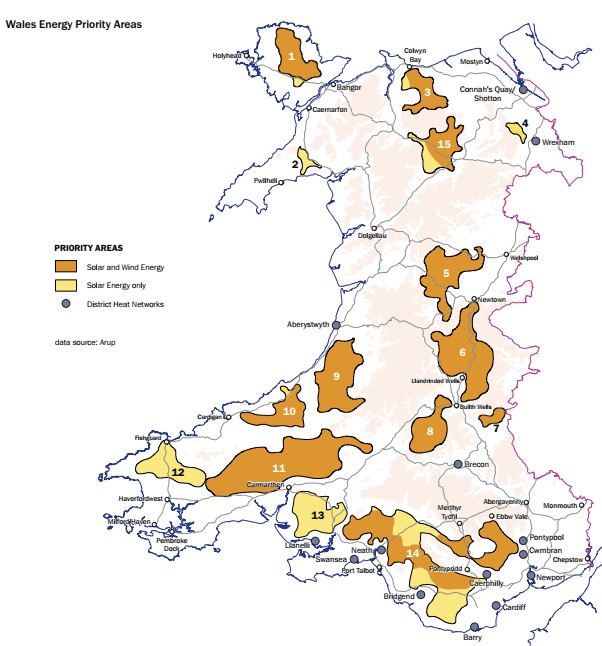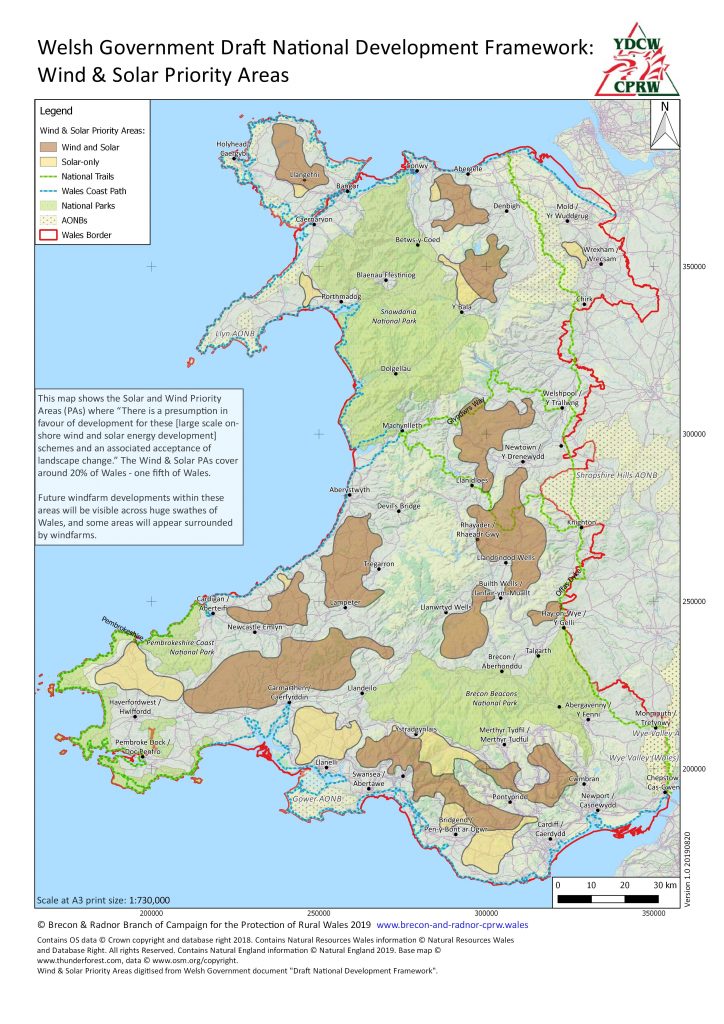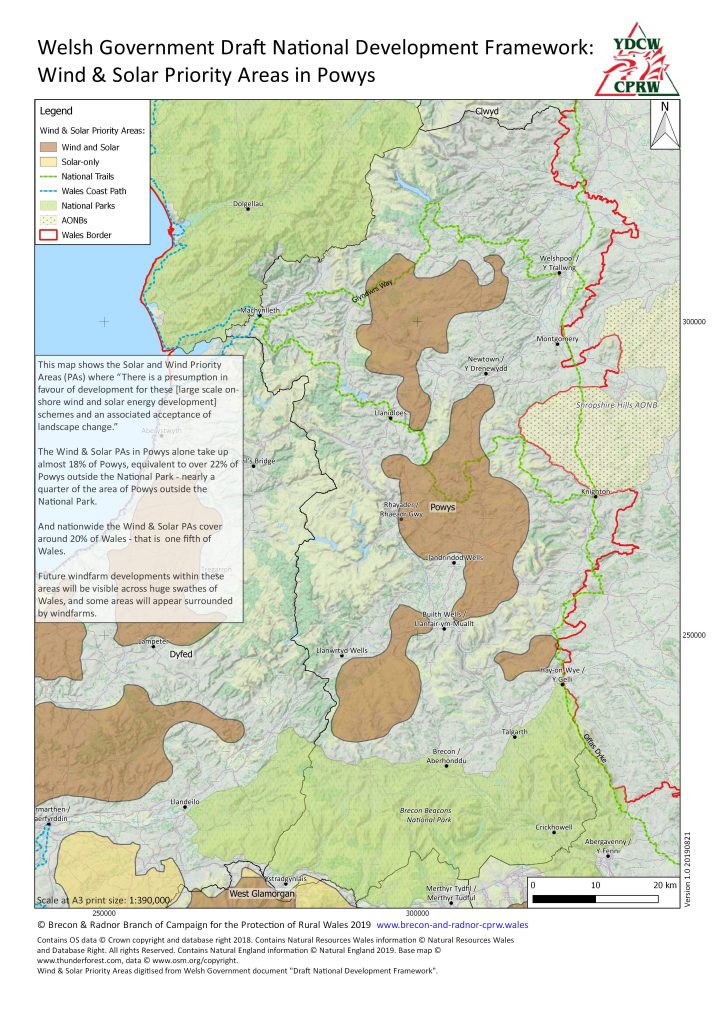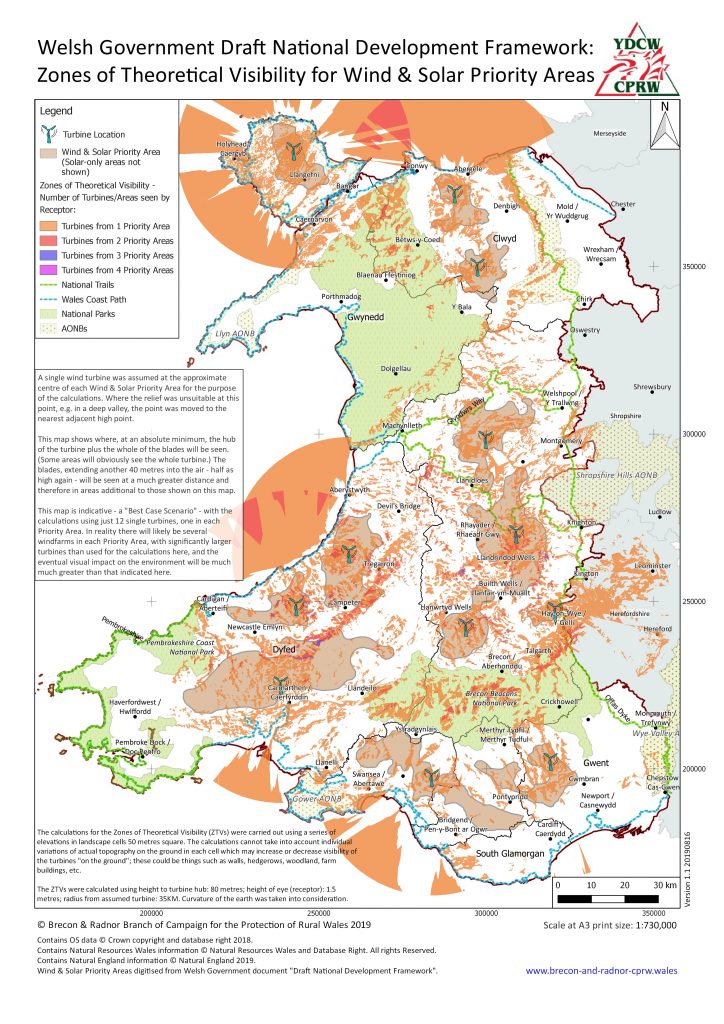DRAFT NATIONAL DEVELOPMENT FRAMEWORK 2019 – WIND AND SOLAR PLAN FOR WALES
LINK TO CPRW RESPONSE TO THE DRAFT NATIONAL DEVELOPMENT FRAMEWORK
The Draft National Development Framework is the Welsh Government’s 20-year spatial plan for shaping the future growth and development of Wales.
It sets what happens to Powys for the next 20 years. We all have a one-off chance to say what we think. The consultation ends on 15th November and will compete for attention with Brexit politics so please spread the news and start thinking about your own response now.
The NDF says “Climate change and the decline in biodiversity are global challenges and the biggest issues faced by our nation”. CPRW Brecon & Radnor fully endorses this statement and agrees that renewable energy is a critical part of the national response but this must be a carefully measured response with full regard to biodiversity and the future needs of rural Wales.
The NDF contains 26 Planning Policies concerning development in Wales: 15 apply throughout Wales and 11 concern regional planning for 3 regions. We are in “Mid and West Wales Region” of Powys, Ceredigion, Pembrokeshire and Neath Port Talbot, including Swansea. The NDF presents a crude map of “priority areas” for wind and solar energy throughout Wales without explaining why or how these have been chosen.

THE KEY DOCUMENTS
Welsh Government consultation – Draft NDF documents and response questionnaire: https://gov.wales/draft-national-development-framework
The ARUP reports below, only published in response to public request, are essential to the NDF but the Draft NDF does not even refer to them.
ARUP reports supporting the designation of Priority Areas for large scale renewable energy development: https://gov.wales/assessment-shore-wind-and-solar-energy-potential-wales
If you would like paper copies of documents, please request these from Russell.dobbins@gov.wales
The general questions in the consultation response form do not capture our concerns but there are boxes where you can enter free style text. We focus on the Draft NDF renewable energy section (especially Policies 10 to 14) but we are also concerned about the other proposals and failure of the development framework to grapple with negative impact of development on biodiversity and preservation of our water, air and soil quality. We will add to our website as the consultation progresses.
OUR MAJOR CONCERNS……
STRATEGIC CENTRALISATION OF PLANNING IN WALES: lack of democracy for rural areas
This 20-year vision for Wales is a further stage in the devolved Welsh Government’s progressive centralisation of major planning decisions. The NDF, combined with Planning Policy Wales 10, will govern a proposed Strategic Development Plan for Mid and West Wales which, in turn, will govern our Local Powys Planning. Hard won protections in our Local Development Plan will be overridden by these two upper tiers of planning law in which residents’ concerns are ever less likely to be reflected. The draft NDF represents a serious erosion of the rights of local communities to have a genuine voice in the development of their areas.
WELSH GOVERNMENT WILL MAKE ALL THE DECISIONS: no understanding of local factors
The Welsh Government has classed all renewable energy projects over 10MW as ‘Developments of National Significance’. Power to make these decisions has been taken away from Local Planning Authorities and reserved for Welsh Ministers. Our experience with the Hendy Wind Farm (see web page) demonstrates the Welsh Ministers’ disregard for local feeling, substantial damage to landscapes, heritage, biodiversity and tourism.
In contrast to proposals for Wales, just across the border, English neighbourhood planning allows communities to have real influence on the development of their local area. Renewable energy planning applications up to 50MW are decided at local authority level. National Policy provides a general framework but decisions are made locally.
HISTORY OF THE POWYS LDP: work on wind and solar local search areas has been overturned
During the examination of the Powys LDP, adopted in April 2018, substantial Proposed Local Search Areas for wind energy were abandoned because the Welsh Government’s chosen consultant, AECOM, finally admitted that, after they had followed Welsh Government guidance and applied the appropriate exclusion criteria, outside the Brecon Beacon National Park and existing Strategic Search Areas for wind farms, there were no suitable areas left in Powys for new search areas for large scale wind.
The LDP was tested for compliance with Welsh, UK and international legislation through the Welsh Planning Inspector’s Examination process. Throughout this, the Welsh Government representative was closely involved in the formulation of renewable energy policy to ensure that the Powys LDP met all relevant Welsh Government requirements.
In the final stages of development of the Powys LDP, AECOM proposed 33 solar Local Search Areas by a process of applying technology specific criteria together with constraints intended to guard against the most harmful local impacts. Following a study of the landscape impacts, commissioned from landscape consultants Enplan, 13 were removed, leaving 20. These remaining areas were then included within the LDP, allocated a potential energy capacity and then given priority rankings for build out. This process contrasts starkly with the ARUP methodology supporting the NDF Priority Area plan. Planning Policy Wales 10 still recommends use of the AECOM toolkit for identifying areas for renewable development, but instead the Welsh Government ignored its own guidance and commissioned the ARUP reports.
Given the conclusions reached in the course of LDP development in Powys, how do Welsh Government now justify disregarding their own guidance to arrive at such different conclusions about Powys’s capacity to absorb so much more large scale wind and solar development?
More information: see our page on the Powys LDP
Map page: NDF Powys Wind and Solar ‘Priority Areas’
NEW PERMISSIVE PLANNING POLICIES FOR WIND AND SOLAR: negative impacts will be brushed aside
NDF Policy 10, applying to applications within Priority Areas, says: ‘The Welsh Government supports large scale on-shore wind and solar energy development in the identified Priority Areas for Solar and Wind Energy. There is a presumption in favour of development for these schemes and an associated acceptance of landscape change’. The NDF does not say whether the new Priority Areas replace or coexist with the Strategic Search Areas set out in Technical Advice Note 8 (TAN8) and the 20 Local Development Policy Solar Search Areas.
The primacy of NDF Priority Areas in the planning system carries the high risk that critically important issues will be ignored. These are:
- spatial planning for ecological conservation and biodiversity
- conservation of the highly valued landscapes of rural Wales
- protection of the Welsh tourist industry fundamental to the survival of many rural communities
No environmental, landscape, amenity, heritage, tourism or other harm is likely to weigh substantially against any wind or solar proposal. Protection of nature conservation areas and habitats will apparently be a secondary consideration relegated to Natural Resources Wales Area Statements and Local Development Plans.
The NDF has “accepted” landscape change on our behalf without presenting any evidence about the value of landscapes in and around the priority areas. And where is any recognition of the intrinsic importance of landscape to communities and to the rural economy? Nearly 70% of UK visitors to Wales come primarily for its landscape and support a thriving tourism economy. Welsh Government’s Wellbeing Goals clearly recognise the importance of ‘sense of place’ to health and wellbeing.
MORE GENERAL CONCERNS……….
- No transparent methodology: Recommendations in Welsh Government’s ‘Toolkit’ guidance, intended to provide some protection of rural residents, our natural environment, landscapes and the rural tourism economy, have been ignored or inconsistently applied. It is very difficult to follow exactly what protective constraints have been applied by ARUP to reach the final Priority Areas. Relatively unconstrained areas of variable average wind-speeds are lumped together with ‘constrained’ areas of high wind speed. The nature of the constraints and how these might be assessed in the planning balance are unclear making decisions based on the NDF wholly subjective.
- Competing existing uses of Priority Area Land: The Welsh Government is proposing changes which have the potential to devastate rural Wales without any apparent high-level research into the impacts. For example, much of Priority Area 8 comprises the MOD Sennybridge Training Area (SENTA) which is a major Field Firing Area for the infantry and artillery, and Priority Area 7 is largely owned by the National Trust but there is no evidence of discussion with the MOD or NT.
- Inefficient energy generation: The ARUP methodology has not considered the critical balance of energy output versus environmental harm for the intended technologies. For instance wind-speed is relevant for wind areas and the additional environmental damage from new grid infrastructure should not be minimised. Wind-speed would have a significant bearing on number and height of turbines and thus adverse environmental impacts on landscape, wild-life and communities. The NDF suggests that turbines of up to 250m will be considered, presumably to ensure viability in poor wind-speed areas.
- Alternatives are not considered: The proposals do not discuss or incorporate the potential for energy savings or the potential for local and community generation which should be at the heart of rural energy planning. At an earlier stage of this NDF, it was stated that ‘NDF policies will provide a framework for the delivery of decentralised, local energy generation and distribution including community owned renewable energy schemes across the whole of Wales’. Welsh policy appears as a series of inconsistent, poorly considered knee-jerk reactions.
- Incompatibility with existing legislation: Recent flagship legislation has committed Welsh public bodies to the ‘sustainable management of natural resources’, ‘sustainable development’ and the “enhancement of resilient ecosystems”, and also to work towards the 7 Wellbeing of Future Generations Goals. The promotion of industrial scale renewable development, including wind turbines up to 250m in height, across much of rural Wales, coupled with a permissive policy which will reduce the weight to be given to local concerns, is not compatible with the objectives of the Environment (Wales) Act or the Well-being of Future Generations (Wales) Act or the Nature Recovery Action Plan (Environment (Wales) Act , Well-being of Future Generations (Wales) Act). Rural areas are being regarded as provisioning areas for urban Wales without regard to their intrinsic benefits and needs.
MAP GALLERY
See also – NDF Wind and Solar Priority Areas.
And Powys Zones of Theoretical Visibility maps can be found here.
(You may view a larger version of, or download, the following maps as PDFs by clicking on the map or right-clicking and selecting “Save target as” or equivalent.)
The following map shows the Zones of Theoretical Visibility (ZTVs) for wind turbines in the Wind & Solar Priority Areas and their likely visibility throughout Wales.
The shading on the maps sets out, according to the key, the areas around the country – and into England – from which wind developments within one or more proposed Priority Areas will be visible. These maps present a very conservative ‘Best Case Scenario’ based on assumptions explained on the maps themselves. In reality the eventual visual impact on the environment will likely be much much greater than that indicated here.



